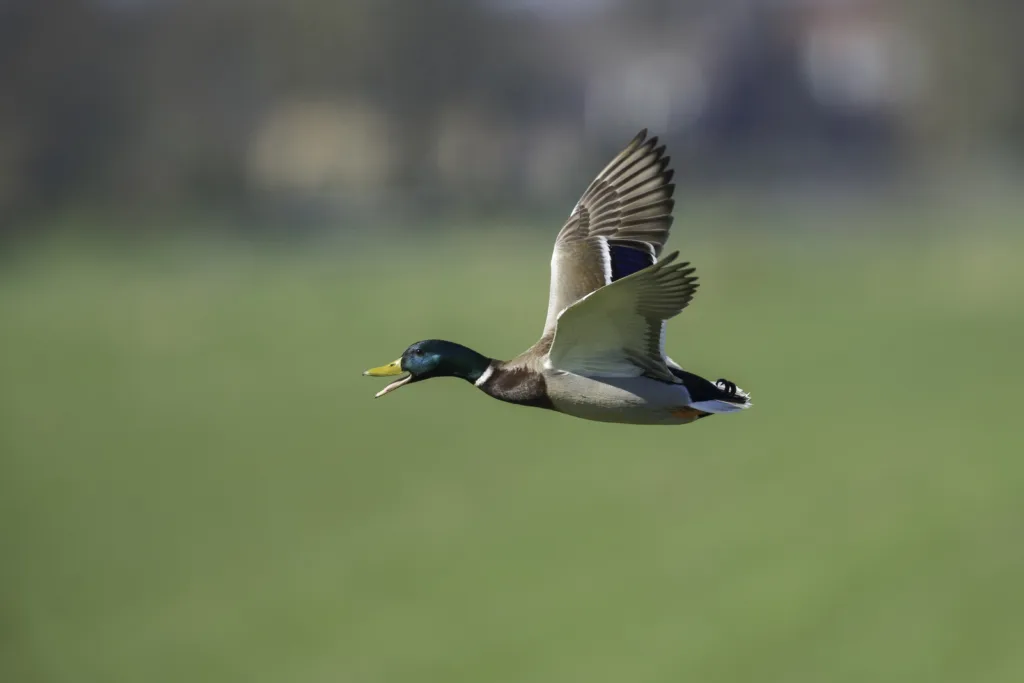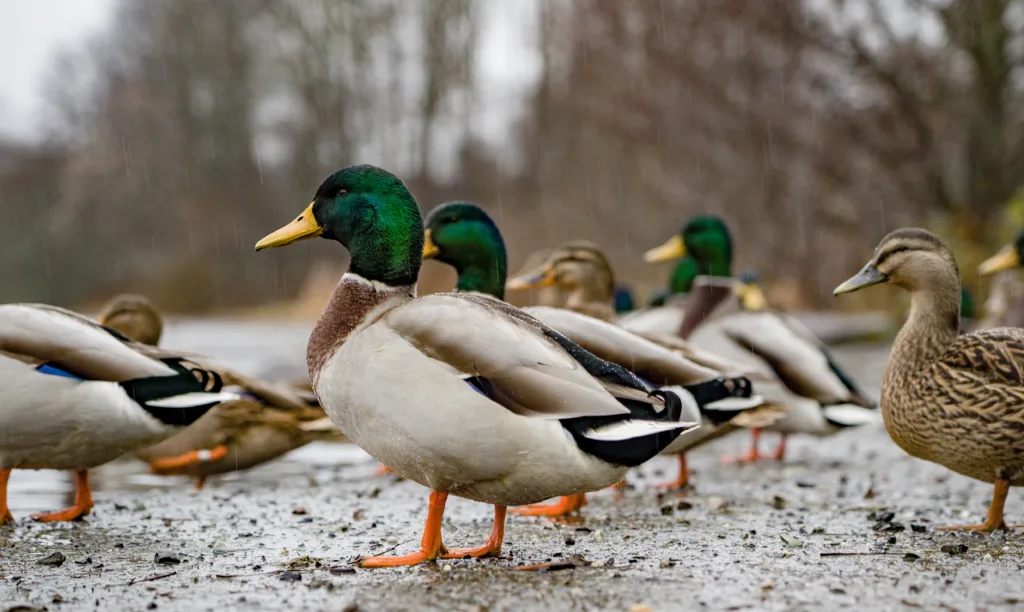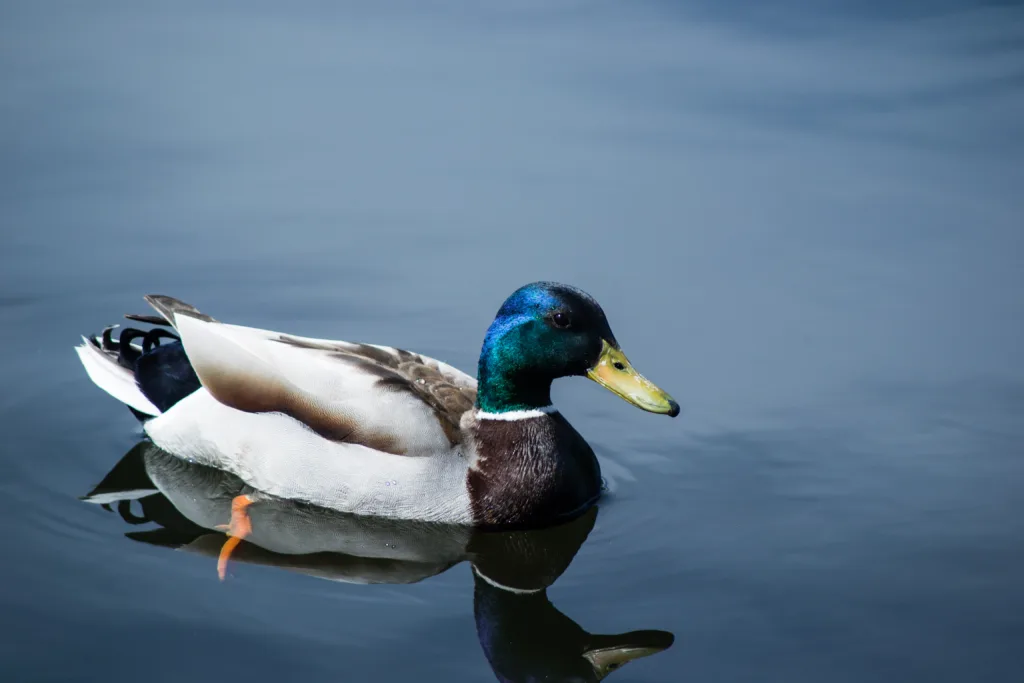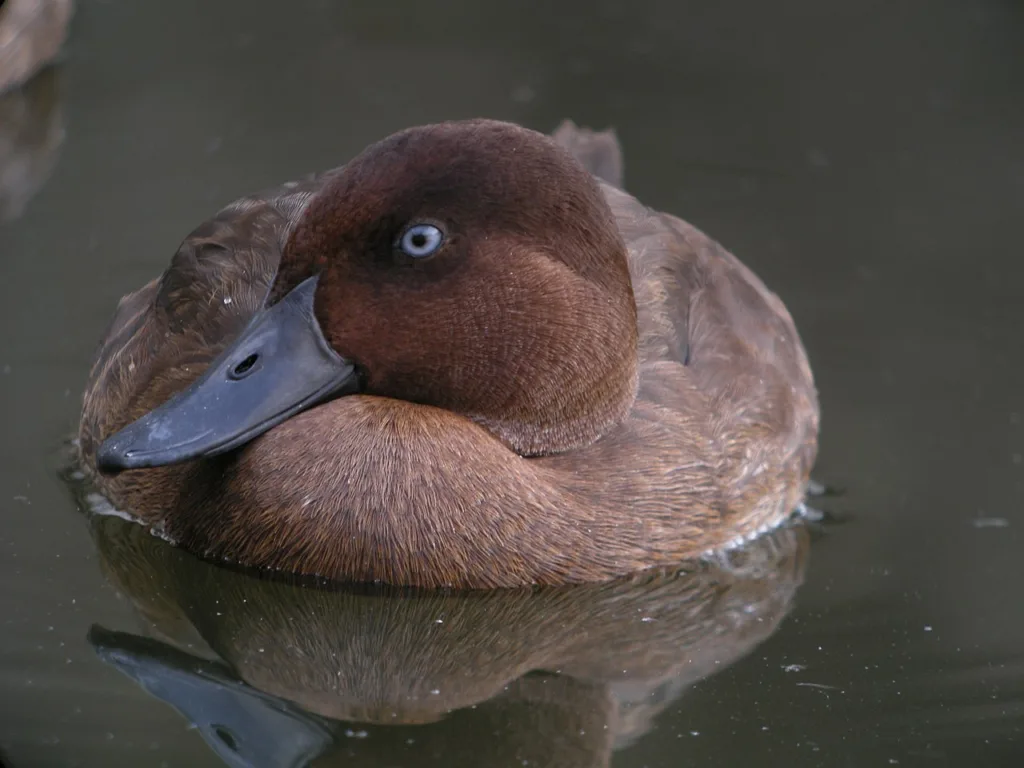Green headed ducks, also known as mallards, are one of the most common and recognizable duck species in North America. They are found in a variety of habitats, including wetlands, ponds, lakes, and rivers. Male mallards are particularly striking with their bright green heads and distinctive white neck ring. But there is more to these ducks than just their appearance.
Let’s take a closer look at the characteristics and behavior of green headed ducks:
Physical Characteristics:
– Male mallards have a dark, iridescent-green head and a bright yellow bill.
– The gray body is sandwiched between a brown breast and black rear.
– Females and juveniles are mottled brown with orange-and-brown bills.
– Depending on the season, and the age and genes of an individual, mallards can look a little different.
– Downy ducklings resemble the ducklings of all other dabbling duck species.
Breeding Season:
– Male mallards have special colorful plumage during the spring and summer breeding season that helps them attract females.
– Their heads and necks are bright green, and at the base of their neck is a white ring.
– During breeding season, males also make a distinctive quacking sound to attract females.
– Females build their nests on the ground, typically near water, and lay between 8-13 eggs.
Feeding Habits:
– Green headed ducks are dabbling ducks, wich means they feed by tipping their heads underwater to eat plants, seeds, and invertebrates.
– They also occasionally dive to catch small fish or aquatic insects.
– Mallards are omnivores and will eat a variety of food sources.
Migration:
– Mallards are a migratory species and will travel long distances to breed and winter.
– During migration, mallards often fly in large flocks that can number in the thousands.
– They typically migrate south to warmer climates in the fall and return north to breed in the spring.
Conservation Status:
– Green headed ducks are considered a species of “Least Concern” by the International Union for Conservation of Nature (IUCN).
– However, they face a number of threats, including habitat loss, hunting, and pollution.
– Conservation efforts are focused on protecting wetlands and other important habitats, as well as regulating hunting and reducing pollution in waterways.
Green headed ducks, or mallards, are a fascinating and important species of waterfowl. Their striking appearance, unique behaviors, and migratory patterns make them a beloved and recognizable species. However, it is important to remember the threats they face and the need to protect their habitats and populations for future generations.
Identifying a Duck With a Green Head
The duck species known as the Mallard (Anas platyrhynchos) is commonly recognized for having a green head. Specifically, the male Mallard has a distinctive, iridescent-green head that contrasts with its gray body, black rear, and brown breast. Additionally, the male Mallard has a bright yellow bill that is relatively long and narrow. In contrast, females and juveniles of the species have a mottled brown appearance with orange-and-brown bills. Therefore, if you see a duck with a green head, it is most likely a male Mallard.

Do Female Ducks Have Green Heads?
In the case of mallard ducks, females do not have green heads. The males of this species are known for their striking emerald green heads, while females have a more subdued brownish-grey coloring. However, it is important to note that the appearance of mallard ducks can vary depending on a variety of factors.
During differnt seasons, the feathers of mallards can change in color and pattern. Additionally, individual variation in genetics and age can also impact the appearance of these ducks.
It is also worth noting that downy ducklings, which are the young of mallard ducks, resemble the ducklings of other dabbling duck species. This is a common trait among many bird species, where young birds have a similar appearance until they mature into their adult coloring.
While female mallard ducks do not have green heads, the appearance of mallards can vary based on a variety of factors, and downy ducklings resemble the young of other dabbling duck species.
The Reason Behind Male Ducks Having Green Heads
Male ducks, also known as drakes, have green heads and necks dring the breeding season, which typically occurs in the spring and summer. This bright and distinctive coloration serves an important purpose – to attract females.
The green color of the male duck’s head and neck is a result of the presence of carotenoid pigments in their feathers. These pigments are acquired through their diet, which includes a variety of foods such as algae, insects, and crustaceans.
During breeding season, male ducks use their colorful plumage to impress females and establish dominance over other males. The bright green color of their heads and necks is especially important in this regard, as it is a highly visible signal of their fitness and genetic quality.
In addition to the green coloration, male ducks also have a distinctive white ring at the base of their necks. This feature, known as a “collar,” further enhances their attractiveness to females.
It is important to note that not all species of ducks have green heads and necks. Some, such as the mallard, have more muted colors during the breeding season. However, the use of colorful plumage to attract mates is a common strategy among many bird species, and is an important aspect of their reproductive behavior.
Identifying a Duck With a White Body and Green Head
The duck that has a white body and a green head is the Common Merganser. This is a large duck species that is known for its long body and long, straight bill. The male Common Merganser has a dark green head with a white body, while the female has a reddish-brown head with a grayish-brown body.
In addition to the distinctive coloring, the Common Merganser is also known for its orange-red bill, which is long and narrow. This bill is perfectly adapted for catching fish, which is the primary diet of this species.
The Common Merganser is found throughout much of North America, and it is known for its ability to dive deeply underwater in search of prey. When swimming, the Common Merganser can oftn be seen with its head submerged as it searches for fish.
The Common Merganser is a fascinating and unique species of duck, with its distinctive coloring, long bill, and impressive diving abilities.
Are Mallards Green Heads?
Green heads are mallards. The mallard (Anas platyrhynchos) is a species of dabbling duck that is found throughout most of the world. The male mallard, also kown as a drake, has a distinctive green head, a white neck ring, and a chestnut-colored chest. The female mallard, or hen, is mottled brown in color.
The mallard is one of the most common and widespread duck species in the world. It is highly adaptable and can be found in a variety of habitats, including wetlands, ponds, rivers, and lakes. Mallards are also a popular game bird and are hunted by many duck hunters.
In addition to being a wild species, mallards are also the ancestor of most domestic duck breeds. This means that many domestic ducks, such as Pekin ducks, have mallard DNA in their genetic makeup.
The green head is a distinctive feature of the male mallard, but it is important to remember that the mallard is a species of duck, not just a single bird with a green head.

The Mystery of Aztec Ducks
Aztec ducks are a Bantam breed of duck that was developed by Dave Holderread in the 1980s. These ducks are smaller than Mallard ducks and are much easier to raise and hatch than Call ducks. The Aztec duck is an exotic-looking breed that is kown for its unique appearance. They have a black and white striped pattern on their feathers that resembles the patterns found in ancient Aztec art.
The Aztec duck is a hardy breed that is well-suited for backyard flocks. They are good foragers and can thrive on a diet of forage and grain. These ducks are also known for their friendly and docile temperament, making them a great addition to any backyard flock.
One of the key advantages of the Aztec duck is its small size. These ducks are ideal for small properties, as they require less space than larger breeds. They also produce smaller eggs, which can be a benefit for those who want to raise ducks but do not need large amounts of eggs.
In terms of care, Aztec ducks require the same basic care as other duck breeds. They need access to clean water, a balanced diet, and protection from predators. They also need a safe and secure shelter to protect them from the elements.
The Aztec duck is a unique and attractive breed that is easy to care for and a great addition to any backyard flock. If you are looking for a smaller breed of duck that is easy to raise and hatch, the Aztec duck may be the perfect choice for you.
The Unusual Sight of a Black Duck With a Green Head
The black duck with a green head is a domestic duck breed known as the Cayuga. This breed is native to the United States, specifically the Finger Lakes region of New York State, and was named after the Cayuga people who inhabited the area. The unique feature of this duck is its iridescent green-black plumage, which can appear almot black in dim light, but shines with a metallic green sheen in bright light. This breed is medium-sized and can lay eggs with a variable color ranging from black to pale green or blue. The Cayuga duck is recognized by the American Poultry Association as a medium-sized duck breed and is suitable for both meat and egg production. the black duck with a green head is known as the Cayuga, a domestic duck breed with iridescent green-black plumage, native to the Finger Lakes region of New York State, and suitable for both meat and egg production.
Do Black Ducks Have Green Heads?
American Black Ducks do not have green heads. Their heads are actually pale gray-brown in color. The yellow-green bill of the Black Duck is one of its distinctive features. It is slightly darker in females than in males, with the latter having a brighter, more olive-colored bill. The overall body color of the American Black Duck is very dark brown, with a slightly lighter shade on the flanks and belly. This species is often confused with the closely related Mallard, whih has a brighter green head and a more mottled body. To summarize, the American Black Duck has a pale gray-brown head and a yellow-green bill, but no green head.
Do Drake Mallards Have a Permanent Green Head?
Drake Mallards do lose their bright green heads during the summer months. This is beause they undergo a process called molting, where they shed their old feathers and grow new ones. During this time, male Mallards will lose their bright green, reddish, black, and white feathers, and replace them with mottled brown ones.
Molting usually occurs in the late summer or early fall, after the breeding season is over. This is also the time when ducks are more vulnerable to predators, so the change in feather coloration helps them blend in with their surroundings and avoid detection.
It’s important to note that not all Mallards will molt at the same time, and some may retain a portion of their bright plumage year-round. However, the majority of male Mallards will undergo this process and temporarily lose their distinctive green heads during the summer.
The answer is yes, Drake Mallards do lose their green heads during the molting process in the summer months. This helps them blend in with their surroundings and avoid detection from predators.

The Significance of the Green Color of Mallard Heads
The green head feathers of the male mallard duck (Anas platyrhynchos) are the result of a fascinating optical phenomenon that arises from the interaction of light with the feathers’ microstructure. The feathers contain stacks of specialized pigment-containing cells called melanosomes, which are arranged in a precise pattern that allos them to reflect and scatter light in a way that produces the characteristic green colour.
Interestingly, the green colour of the mallard’s head feathers is not a result of green pigments. Instead, it is caused by a combination of blue and yellow light reflecting off the melanosomes in the feathers. The blue colour comes from the structure of the melanosomes themselves, while the yellow colour comes from the keratin proteins that make up the feather’s structure.
In addition to the green head feathers, male mallards also have a distinct patch of iridescent feathers on their wings known as the speculum. Like the green head feathers, the speculum’s iridescent blue colour comes from the interaction of light with the feather’s microstructure. In this case, the feather’s barbules are arranged in a way that creates a layered structure, causing the incoming light to interfere with itself and produce the brilliant blue colour.
In contrast, female mallards have more muted colours, with brownish feathers and a less distinct speculum. This difference in appearance between the males and females is known as sexual dimorphism and is thought to play a role in courtship and mate selection.
The green head feathers and blue speculum of the male mallard duck are the result of complex optical interactions between light and the microstructure of the feathers. These features help to distinguish males from females and are likely important in mate selection and reproduction.
The Presence of Two Male Ducks with a Female Duck
In the animal kingdom, it is not uncommon to observe two male ducks, also known as drakes, accompanying a female duck, known as a hen. This behavior is ofen seen during the breeding season, which typically occurs between November and May.
The presence of two male ducks with a female serves multiple purposes. Firstly, it allows the hen to have undisturbed feeding time while the two males keep a lookout for potential predators. This is particularly important during the breeding season when hens require more nutrients to lay eggs.
Secondly, the presence of two males helps to defend the male’s paternity. Unpaired males will vigorously attempt to mate with unguarded females, which could result in the offspring being sired by a different male. By having two males present, it increases the chances of the female being guarded and reduces the likelihood of other males mating with her.
It is worth noting that despite the best efforts of paired drakes, genetic analysis has shown that many broods contain ducklings sired by different male parents. However, having two males present still increases the chances of the female being guarded and reduces the risk of other males mating with her.
The presence of two male ducks with a female serves to provide protection for the female while she feeds and defends the male’s paternity by reducing the risk of other males mating with her.
The Rarity of Hybrid Ducks
Hybrid ducks are not as rare as one might think. In fact, waterfowl crossbreed more often than any other family of birds, with over 400 hybrid combinations beng recorded among waterfowl species. Mallards and wood ducks, in particular, are known to hybridize with a wide range of other species.
While the occurrence of hybrid ducks may not be rare, it is important to note that hybridization can have negative impacts on the genetic integrity and survival of the species involved. This is because hybrids may have reduced fitness, making them less able to survive and reproduce in the wild.
Some examples of hybrid ducks include:
– Mallard x American Black Duck
– Mallard x Northern Pintail
– Mallard x Gadwall
– Mallard x American Wigeon
– Mallard x Green-winged Teal
– Wood Duck x Mallard
It is worth noting that hybrid ducks can be difficult to identify, as they may have a combination of physical traits from both parent species. DNA analysis is often required to confirm hybridization.
The Rarest Waterfowl Duck
The world’s rarest waterfowl duck is the Madagascar pochard, also known as Aythya innotata. This critically endangered species was once believed to be extinct until its rediscovery in 2006, aftr 15 years without any sightings. The Madagascar pochard is found only in the wetlands of Lake Alaotra in Madagascar, which is the largest lake on the island.
The Madagascar pochard is a medium-sized diving duck, with a distinctive black and white pattern on its plumage. It is a herbivore and feeds on aquatic plants, seeds, and insects. The main threats to this species are habitat loss, hunting, and introduced predators such as rats and cats.
Efforts to save the Madagascar pochard from extinction have been ongoing since its rediscovery, with a focus on captive breeding and reintroduction into the wild. In 2018, a group of Madagascar pochards was released into the wild as part of a pioneering conservation project. This was a major milestone in the efforts to save this critically endangered bird from extinction.
Currently, it is estimated that there are less than 50 individuals of the Madagascar pochard left in the wild, making it the rarest waterfowl duck in the world. Conservation efforts continue to be crucial for the survival of this species, and it is hoped that the population will continue to grow with successful breeding and reintroduction programs.

Identifying My Duck
If you’re looking to identify your duck, there are seeral key features to look for. Firstly, consider the size of the duck – this can give you a good indication of what species it might be. Next, take a look at the head – are there any distinctive markings or colors? The bill is also an important feature to consider, both in terms of size and color. The length of the neck can also be a helpful identifier, as can the colors of the back, rump, neck, breast, and flanks.
Another key feature to look for is the duck’s speculum – this is a patch of iridescent color on the secondary feathers of the wings. The color of the speculum can be a unique identifier for different duck species.
To help you keep track of all these features, it can be helpful to create a checklist or use a field guide to ducks. This can help you quickly and easily identify different species based on their key features. Additionally, if you’re unsure about the identification of a particular duck, consider taking a photo and consulting with an expert or using an online identification tool.
The Meaning of an Emerald Duck
An emerald duck is a type of hybrid duck that is a cross between a muscovy duck and a mallard duck. This crossbreed is typically referred to as a “mule” duck, and it is sterile. Emerald ducks have a unique mix of characteristics from both species, including a distinctive emerald green color on their heads and necks, which gives them their name. Some other physical features of an emerald duck include a flat beak, webbed feet, and a rounded body shape.
Muscovy ducks are known for their large size, meaty flavor, and warty red facial skin, while mallard ducks are smaller and have a distinctive green head and white neck ring. The emerald duck is a fascinating hybrid that combines elements of both of these species to create a unique and interesting bird.
In terms of behavior, emerald ducks are typically more docile and quiet than other types of ducks, and they are less liely to quack loudly or flap their wings. They are also good foragers and can find food in a variety of environments.
The emerald duck is a fascinating and unique hybrid that is sure to capture the interest of anyone interested in ducks or crossbreeding.
Conclusion
Male Mallards are a common sight in many bodies of water across North America. They are easy to identify due to their distinct physical features. The males have dark green heads, a yellow bill, a gray body, a brown breast, and a black rear. Females and juveniles, on the other hand, have mottled brown feathers with an orange-and-brown bill.
It’s important to note that the appearance of mallards can vary depending on their age, season, and genes. However, during the breeding season, male mallards exhibit a special colorful plumage to attract females. They have bright green heads and necks, with a white ring at the base of their neck.
The Common Merganser is anther duck species that sports a green head. These ducks are much larger than mallards, with a long body and a straight bill. They are mostly white, with a green head and an orange-red bill.
Green-headed ducks are a fascinating group of birds that are easily identifiable by their distinct physical features. Male mallards and common mergansers are two common species that exhibit this unique trait. Whether you’re a bird watcher or simply enjoy observing nature, these ducks are a beautiful sight to behold.
